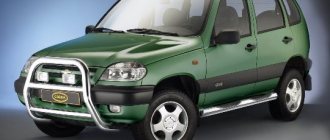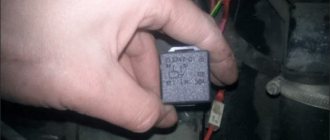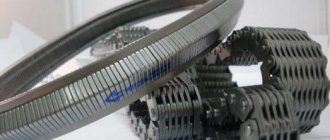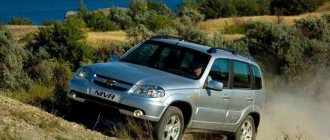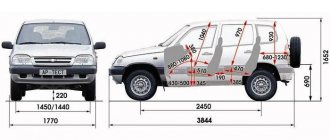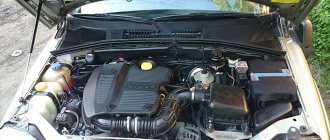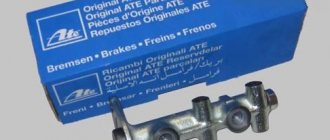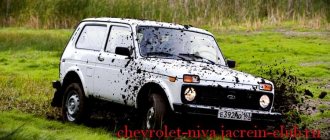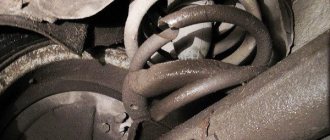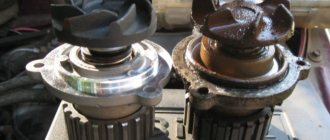The Chevrolet Niva has repeatedly undergone modernization, which has increased the convenience and comfort of driving, but the nuances with the transmission and engine have not yet been resolved. About 99% of the former owners of this vehicle remain dissatisfied, while only those who recently purchased it praise the car.
Careful and regular maintenance, which should not be neglected from the first days of purchase, helps correct this trend. To repair a Niva Chevrolet with your own hands as rarely as possible, immediately after purchase, tighten all the bolts and lubricate the door hinges and locks, otherwise you will encounter problems within the first thousand kilometers. What else should the driver know about and what are the features of repairing this vehicle?
Getting to know the car
The Niva belongs to the category of elegant SUVs, which were the first result of cooperation between Auto VAZ and General Motors. Driving along a city street can be safely called convenient and comfortable; the car is suitable for going to the country on weekends, or for a family trip with a group of three people. The car also feels at ease where a smooth road is replaced by an aggressive off-road. Among the features of the Chevy Niva are the following:
- new modern monocoque body;
- the engine is not connected to the front axle gearbox;
- all-wheel drive is permanent;
- unification of rear and front driveshafts;
- extension of the intermediate shaft;
- The design of the gearbox drive has been modernized, as well as the brake system.
Self-repair Chevrolet Niva
The body has a beautiful design. The Niva-Chevrolet vehicle is the product of work and design solutions in the collaboration of the General Motors and AvtoVAZ concerns.
The SUV is designed for comfortable driving on flat roads in the city, as well as for traveling in rural areas.
The car copes well with long trips: it can easily accommodate several people, and the trunk is so spacious that you can easily place a large number of things there. The all-wheel drive box ensures movement in off-road or highway conditions. Car maintenance is an important car care item that needs to be taken into account.
Weak spots
Advance knowledge about the weak points of the vehicle allows you to carry out repairs on the Chevrolet Niva in a timely manner and prevent major breakdowns. Let's look at them:
- The engine is dull during acceleration, at 30 thousand km. mileage, the seals may already fail. A warranty replacement is possible only if oil leakage is obvious. If the seals are simply wet, you will have to rely on your own strength. The power of the power unit drops when the air conditioning system is activated, which is immediately noticeable when driving along the highway. Poor dynamics and high fuel consumption can be corrected by flashing and doing it better right away. On average, the motor can withstand a resource of up to 250 thousand km.
- The chassis is weak in hubs, torque rods, steering linkage elements, as well as oil seals and ball joints. Often after 30 thousand km. drivers are forced to change the front wheel bearing. The resource of factory racks is also small.
- In terms of the cooling system, it is worth paying attention to the need to replace the antifreeze tank after about a year. With a high degree of probability, it will already leak during this time. Sometimes the pump fails even before the first maintenance.
- The transmission suffers from weak bearings and crosspieces on the driveshaft. The cardans themselves cannot be called a strong point either.
- If we consider the exhaust system, on average it serves flawlessly for about 55 thousand km, but you should be prepared for the fact that if you use low-quality gasoline, the catalyst will fail after just a couple of refills.
- The body, especially the wheel arch area, is susceptible to corrosion. Tangible problems can be noticed as early as 3-4 years. Rust penetrates the scratch within a few days. The paint on plastic elements does not please the eye for a long time.
- In terms of electricians, it is quite rare, but power windows may fail in the first six months. The same resource can be predicted for the starter, belt and generator. The fuel level sensor may display incorrect information if the vehicle position is inclined. Problems also arise with the cooling fan wiring fuses.
- It is better to replace the headlights with LED ones immediately after purchase, otherwise the housing will soon be melted.
- There is almost no sound insulation in the cabin, this is especially noticeable at 100 km/h. Also, many are upset by the lingering of foreign odors into the cabin.
Maintenance frequency
It is worth carrying out repairs and maintenance of the Niva Chevrolet yourself, taking into account the following time periods:
- Check the oil level in the engine block, washer water, brake fluid, and coolant weekly. You should also pay attention to optics, tires and batteries. If the car is not used regularly, the frequency of such checks is 400 km.
- Change the oil filter and oil every 8 thousand km, which will extend the life of the power unit.
- Every 15 thousand km, check the remaining thickness of the front brake pads. The air filter of the ventilation system should also not be ignored.
- Check the condition of the gearbox, washers and electrical systems, suspension, brakes and steering annually. Also lubricate all moving parts on the door panels and trunk. If the SUV is diesel, it is important to monitor the number of crankshaft revolutions at idle. The integrity of engine compartment elements, hoses and connections must also be monitored.
- The air filter must be replaced every 30 thousand km. Do not forget to check how well the drive belts are tensioned. Fuel filters or spark plugs must also be replaced, depending on the type of fuel used. Suspension repairs are not excluded at this time.
- Every 60 thousand km, change the lambda probes and gearbox oil. Repair of body parts is not excluded. Even the slightest scratches cannot be ignored, since corrosion affects this car extremely aggressively. At this stage, the stove can also become weak; you can fix the damage yourself. Even if you service and repair your car yourself, still periodically contact a service station, where they will carry out the necessary measurements of the level of harmful emissions.
Repair features
Repair of the main functional components of the SUV in question has the following features.
Engine
Since the car is specific and the design is not complicated, there will be no surprises in terms of repairs.
Changing the air filter and oil is extremely simple. As for the oil filter, it is located on the side of the block, so it is not easy to get to it. Stock up on 3.75 liters of oil and a hexagon. There is no need even for a lift or a pit, since the ground clearance is quite high. Raising the car makes sense only if there is serious crankcase protection.
A burst expansion tank can also become a problem, and this happens due to its unfortunate shape. Inconsistent lid quality also aggravates the situation.
A burst oil supply tube can cause failure of the hydraulic timing chain tensioner. A clanging metallic sound will be the first sign of such a problem.
In general, the layout for independent implementation of repair and maintenance work under the hood is quite convenient. The only difficulty may be removing the starter, while adding fluid, replacing the air filter or lamps will not create problems at all.
Transmission and chassis
When buying a Niva that is not the first freshness, pay attention to the presence of increased vibrations if the previous owner had the habit of driving without one cardan. In this case, the transfer case supports may not be suitable. In general, the statistics on gearbox breakdowns are quite meager, which indicates the decent reliability of this unit, but the same cannot be said about the clutch. All cylinders, both worker and main, must be replaced. It is noteworthy that it is better to change the mechanism completely than to follow the lead of the green toad and buy a repair kit.
As for changing the oil in gearboxes and gearboxes, it should be the same - 75w-90, and the volumes are as follows:
- 1.3 l for the rear axle;
- 1.15 l for the front gearbox;
- 0.79 l for transfer case;
- 1.6 l for gearbox.
Wheel bearings are a weak point and must be replaced up to 3 thousand kilometers. The front suspension silent blocks and levers are not protected in any way, and in the case of SUVs, unsuccessful tests can lead to serious repairs.
Design of a Chevrolet Niva car
- Repair manuals
- Repair manual for Chevrolet Niva 2002+.
- Car device
1.0 Car structure General information about cars Passport data Car keys Controls Heating and ventilation of the interior Doors Seat belts Adjusting the position of the front seats Adjusting the steering wheel Rear-view mirrors Interior lighting Sun protection...
1.1 General information about cars Cars of the Chevrolet Niva family represent a further development of the concept of domestic comfortable SUVs, which began with the VAZ-2121 Niva car. They differ from their predecessors in modern design, increased comfort and more advanced design…
1.2 Passport data The model and number of the vehicle, engine model, name of the manufacturer, design options and configurations are indicated on the identification plate... ...attached with tear-off rivets in the engine compartment on the front panel extension on the right side. ...
1.3 Car keys Two keys are attached to the car, each of which can unlock the doors and turn on the ignition. USEFUL ADVICE Save the tag: if you lose your keys, you can order new keys from the manufacturer using their number so as not to change the locks. This is what it looks like...
1.4 Controls Fig. 1.8. Instrument panel and controls The location of the controls is shown in Fig. 1.8. Instrument panel 1 – exterior lighting switch. The switch block contains two mechanically connected switches: – side switch ...
1.5 Heating and ventilation of the interior Fig. 1.8. Instrument panel and controls Fig. 1.13. Interior heating and ventilation controls: 1 – front door glass blower nozzles; 2 – air duct for blowing the windshield; 3 – upper nozzles; 4 – regulator of additional air supply through the upper...
1.6 Doors Locks The locks of all doors are unlocked with one key, which also turns on the ignition. The side doors are opened by pulling the outer... ...or inner handle. NOTES If the ignition is on, when you open the driver's door the buzzer...
1.7 Seat belts Seat belts are an effective means of protecting the driver and passengers from serious injuries in road accidents. Therefore, while driving, be sure to fasten your seat belt and do not carry passengers who are not wearing seat belts. The car is equipped with front (inertial...
1.8 Adjusting the position of the front seats To ensure the most comfortable seating for people of different heights and builds, the position of the driver and front passenger seats can be changed both in the longitudinal direction and in the angle of the backrest. In addition, the headrest can be adjusted in height and angle. ETC…
1.9 Adjusting the position of the steering wheel The car is equipped with a steering column that is adjustable in angle. Before driving, adjust the position of the steering wheel so that it is convenient to drive the car and at the same time so that the instruments in the combination are clearly visible. NOTE We recommend adjusting the position...
↓ Comments ↓
1. Car structure
1.0 Car structure 1.1 General information about cars 1.2 Passport data 1.3 Car keys 1.4 Controls 1.5 Heating and ventilation 1.6 Doors 1.7 Seat belts 1.8 Adjusting the position of the front seats 1.9 Adjusting the steering wheel
2. Recommendations for use
2.0 Recommendations for operation 2.1 Safety rules and recommendations 2.2 Tools and accessories 2.3 Running in the car 2.4 Operating the car during the warranty period 2.5 Checking the car before leaving 2.6 Replacing the air filter entering the cabin 2.7 Using a jack 2.8 Towing the car
3. Problems along the way
3.0 Malfunctions along the way 3.1 The engine does not start 3.2 Malfunctions of the fuel injection system 3.3 No idle speed 3.4 Interruptions in engine operation 3.5 The car moves jerkily 3.6 The car accelerates poorly 3.7 The engine stalls while driving 3.8 The oil pressure has dropped
4. Engine
engine piston of the fourth cylinder to the TDC position of the compression stroke
5. Transmission
5.0 Transmission 5.1 Clutch 5.2 Possible malfunctions of the clutch, their causes and solutions 5.3 Gearbox 5.4 Possible malfunctions of the gearbox, their causes and solutions 5.5 Transfer case 5.6 Possible malfunctions of the transfer case, their causes and solutions 5.7 Driveshaft 5.8 Possible malfunctions of the driveshaft , their causes and solutions 5.9 Front wheel drives
6. Chassis
6.0 Chassis 6.1 Front suspension 6.2 Possible malfunctions of the front suspension, their causes and solutions 6.3 Rear suspension 6.4 Possible malfunctions of the rear suspension, their causes and solutions 6.5 Shock absorbers
7. Steering
7.0 Steering 7.1 Design features 7.2 Inspecting and checking the steering on the vehicle 7.3 Checking the tension and adjusting the power steering pump drive belt 7.4 Replacing the fluid in the power steering hydraulic system 7.5 Replacing the power steering hydraulic system reservoir 7.6 Bleeding the power steering system 7.7 Adjusting the gap in the roller engagement with worm 7.8 Removing and installing the steering wheel 7.9 Replacing steering shafts
8. Brake system
8.0 Brake system 8.1 Device features 8.2 Useful tips 8.3 Checking and adjusting the brake system 8.4 Replacing brake fluid 8.5 Bleeding the hydraulic brake system 8.6 Master brake cylinder 8.7 Vacuum brake booster 8.8 Pressure regulator 8.9 Replacing hoses and pipelines of the hydraulic brake system
9. Electrical equipment
9.0 Electrical equipment 9.1 Design features 9.2 Fuses and relays 9.3 Generator 9.4 Possible generator malfunctions, their causes and solutions 9.5 Starter 9.6 Possible starter malfunctions, their causes and solutions 9.7 Ignition switch (lock) 9.8 Replacement and maintenance of spark plugs 9.9 Engine control system
10. Body
10.0 Body 10.1 Design features 10.2 Removing and installing front fender liners 10.3 Removing and installing front fenders 10.4 Removing and installing decorative trims on the front fenders and doors 10.5 Replacing buffers 10.6 Removing and installing radiator trim 10.7 Removing and installing the hood 10.8 Removing, installing and adjusting the lock and hood lock drive 10.9 Tailgate
11. Vehicle options
11.0 Vehicle options 11.1 Clutch release master cylinder 11.2 Electromechanical power steering 11.3 Brake system
12. Car care
12.0 Car care 12.1 Checking the car before leaving 12.2 Washing the car
13. Purchase of spare parts
13.0 Purchasing spare parts 13.1 Engine oil 13.2 Greases 13.3 Coolants 13.4 Brake fluid
14. A trip to the service station
14.0 A trip to the service station 14.1 Useful tips
15. Winter operation of the car
15.0 Winter operation of a car 15.1 How to prepare a car for winter 15.2 Recommendations for starting the engine in severe frost 15.3 What is useful to buy for winter 15.4 Useful winter tips
16. Preparation for technical inspection
16.0 Preparation for technical inspection 16.1 Recommendations 16.2 List of malfunctions and conditions under which the operation of vehicles is prohibited 16.3 Changes to state standards regulating the maximum permissible content of harmful substances in the exhaust gases of vehicles 16.4 Standard form of diagnostic card for instrumental control points
17. Applications
17.0 Appendix 17.1 Appendix 1. Tightening torques for threaded connections 17.2 Appendix 2. Basic data for adjustments and control 17.3 Appendix 3. Fuels and lubricants and operating fluids 17.4 Appendix 4. Filling volumes 17.5 Appendix 5. Lamps used on vehicles 17.6 Appendix 6. 17.7 Appendix 7.
